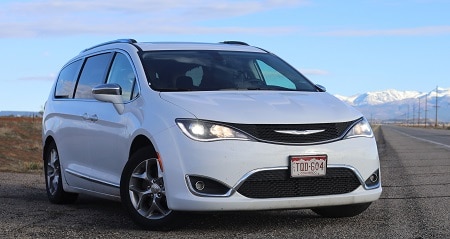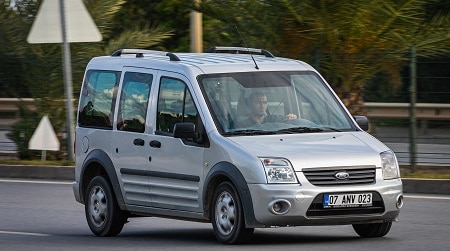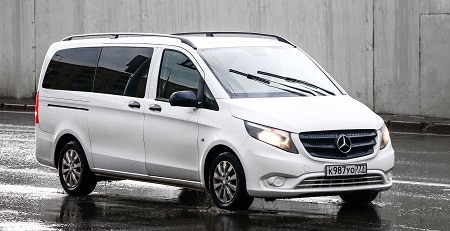These are the main differences between a minivan and a passenger van:
- Minivan – A vehicle built on a unibody small-car platform with a maximum capacity of up to 8 passengers. Typically used for personal use.
- Passenger van – A larger box-shaped van built on a body-on-frame platform with a maximum capacity of 12 to 15 passengers. Typically used for business purposes.
One of the key differences between these two vehicle types is that minivans are designed as family vehicles with a more car-like design, road behavior, and exterior dimensions.
While passenger vans are larger and more work van-like as they’re built on the same platform as cargo vans, hence why they drive more like a truck than a car.
This is also why minivans are usually used as family vehicles while passenger vans are typically used as rental or shuttle service vehicles.
A good example of a popular minivan is the Honda Odyssey, while some of the more popular passenger vans include the Ford Transit passenger van wagon and the Mercedes-Benz Sprinter passenger van
To help you get a better idea of how similar or different minivans and passenger vans are, in this article, I’ll cover the following topics:
- An in-depth look at the main differences between minivans and passenger vans.
- The complete definition and explanation of what minivans and passenger vans are.
- The pros and cons of minivans and passenger vans.
- The most popular minivan and passenger van models.
Minivans vs Passenger Vans – Top 7 Differences
Despite sharing some similarities, minivans and passenger vans are still quite different.
And these are the 7 primary differences between them that you need to know about:
1. Minivans are Easier to Drive and Park
Since minivans are based on the same platform as cars, they offer car-like handling and overall driveability.
Minivans are also smaller and more compact than passenger vans, making them easier to maneuver around town and park in tight spaces.
2. Passenger Vans Can Carry Much More Passengers
Passenger vans are longer and wider than minivans, which means that they can carry almost twice as many passengers.
A passenger van can carry anywhere from 12 to 15 people, while the maximum seating capacity of a minivan is 8 passengers.
3. Minivans use Less Fuel

Minivans are equipped with less powerful engines that are also less thirsty than those in larger passenger vans.
Minivans are also smaller and lighter, which makes them even more fuel-efficient.
That’s why an ordinary minivan might return around 17 MPG, while the typical passenger van might return only around 14 MPG.
4. Passenger Vans are Typically Used for Work Purposes
The most common use of passenger vans these days is for business purposes in various niches.
For example, passenger vans make for great shuttle service or rental vehicles as they’re an optimal choice for transporting larger groups of people.
5. Minivans are Designed as Family Vehicles

The roomy interior and storage capacity of minivans is meant to make the lives of families easier by offering more space than a regular sedan, while still being more car-like than a full-size van.
That’s why most minivans are used for private purposes such as family travel.
6. Passenger Vans Can Tow Heavier Things
Due to the size, more robust design, and typically more powerful engines, passenger vans can tow much heavier objects than minivans.
For example, the Mercedes-Benz Sprinter passenger van has a maximum towing capacity of 5,000 lbs, while the Honda Odyssey minivan has a maximum towing capacity of 3,500 lbs.
7. Minivans are Easier to Get in and Out of
Because minivans sit lower than passenger vans, they are easier to get in and out of.
Although the taller design of bigger full-size vans offers heaps of interior headroom, it also means that their doors sit higher, making these vans slightly harder to enter into.
This is What a Minivan Is

A minivan is a vehicle designed to transport passengers built on a unibody platform that usually comes with front-wheel or all-wheel drive.
It’s primarily designed as a family vehicle that comes with notable features such as the 1-box or 2-box body configuration, a high H-point seating, a sliding rear side door, a higher roof, and a flat floor.
Although minivans are built on the same platform as small cars, they have unique characteristics such as sliding or hinged rear doors and lower ground clearance than SUVs and full-size vans.
Minivans come with reconfigurable seats in 2 or 3 rows that can carry up to 8 passengers.
They’re also available in different sizes that fall under the following sub-categories:
- Micro minivan.
- Compact minivan.
- Medium minivan.
- Full-size minivan.
There are also different builds within the minivan vehicle classification, including:
- One-volume (without a hood).
- One-and-a-half-volume (with half a hood).
- Two-volume (with a complete hood).
Minivans also offer many amenities and tech gadgets found in some cars as they’re built on the same platform.
This, along with the spacious interior, is one of the main reasons why minivans are popular among larger families.
These are the Most Luxurious Minivan Features
Contrary to popular belief, some higher equipment minivans come with features that can rival premium sedans.
Here are 10 of the most luxurious features found in modern minivan models:
- Air-cooled seats
- 360° view parking assistance
- Integrated vacuum cleaner
- Gas station finder
- Adaptive radar cruise control
- 2nd-row lounge chairs
- Integrated rear window sunshades
- Infotainment system with a touch screen
- Automatic side doors that open with a foot swipe
- Built-in microphone that amplifies the driver’s voice through the rear speakers
It’s worth mentioning that some of these features aren’t even available in cars, making them even more exclusive.
This is What a Passenger Van Is

A passenger van is a large van designed to transport passengers, mainly for commercial purposes.
These vans are typically used for shuttling people from airports to hotels or when bigger groups need fast and convenient transportation from A to B.
Depending on the registration plates and use, a passenger van can be used as a shuttle van without the driver needing a valid commercial driver’s license.
Passenger vans are built on frame-on-box platforms and they usually rely on rear-wheel drive, although 4×4 is available on some models.
These vehicles have several key characteristics such as:
- Seating capacity – You can choose between a seating capacity of 12 or 15, depending on the wheelbase length of the van.
- Accessibility – These vans can be upfit with modifications like bus doors and wheelchair lifts for various accessibility needs.
- Roof height – There are several roof heights to choose from such as low, medium (or standard) and high.
- Wheelbase – This is the measurement between the vehicle’s axles and passenger van’s typically come in short (or standard) and long-wheelbase options that affect the overall seating capacity.
Note that passenger vans and cargo vans share the same platform as they’re basically the same vehicle, with the only difference being the seats or lack of them.
The Most Luxurious Passenger Van Features
Although minivans are more luxurious in general, passenger vans have a few tricks up their sleeve as well.
These vans are available with certain high-end technology and features such as:
- In-vehicle WiFi hotspot
- Multimedia system with touchscreen
- Blind spot assist mirror
- Active lane-keeping assist
- 360-degree camera
- Active distance assist Distronic
- Forward collision warning
- Pre-collision assist with automatic emergency braking
However, note that most of these fancy functions are only available as optional features that you need to pay extra for.
The Pros and Cons of Minivans and Passenger Vans
Below I’ve hand-picked the primary pros and cons of both vehicle types.
Starting with the smaller, car-like vans:
Minivan Pros

- Car-like handling and ride quality.
- Sliding doors help minimize door dings when parking in tight spaces.
- Flexible and customizable interior configuration.
- Better fuel economy than larger vans.
- Easier to get in and out of due to the lower ground clearance.
- Great infotainment options for all passengers (including the ones sitting in the rear seats).
- More small family-friendly than larger passenger vans.
- Most minivans are less expensive than full-size vans.
- Typically minivans have lower insurance rates than bigger passenger vans.
Minivan Cons

- Not big enough if you need to transport a large group of people (more than 8 passengers).
- Less optimal for business purposes if it’s to be used as a shuttle service vehicle.
- Worse towing capabilities than larger passenger vans.
Passenger Van Pros

- Huge amount of passenger space (up to 15 seats).
- A much better towing capacity than a minivan.
- Makes for a superb rental van or shuttle service vehicle.
- A great choice if used for business purposes.
- Can be customized to accommodate the needs of disabled passengers.
- A great option for van conversion projects (e.g. camper conversion).
- Can double as a daily-driver van if needed (unless it’s registered as a commercial vehicle).
Passenger Van Cons

- More difficult to park in tight spaces and maneuver around town.
- Worse ride quality and handling than minivans.
- The fuel economy is not that great.
- Harder to get in and out of due to the higher stance.
The 5 Most Popular Minivan Models
These are the 5 most popular minivan models including everything you need to know about each model:
1. Chrysler Pacifica

| Starting Price: | $38,590 (manufacturer’s suggested retail price) |
| Feature Highlights: | Power doors Hands-free doors Pedestrian detection Parallel automatic parking Start/stop system Panoramic moonroof Hands-free trunk Cooled seats (front only) Third row 3 years or 36,000 miles basic warranty 10 years or 100,000 miles Hybrid/EV warranty |
| Pros: | Lots of standard safety features Smooth and quiet ride Hybrid-powered models available |
| Cons: | Expensive starting price No 4×4 for the hybrid version |
| Overview |
| The popular Chrysler Pacifica is one of the leading minivans currentl, it comes with a spacious and quiet interior that has enough seating capacity of up to 8 passengers. This American model is available with lots of modern features, including fully folding seats to provide additional cargo space. There are 4 trim levels available, while power comes from a 3.6L V6 engine mated to a 9-speed automatic transmission with 2 drivetrain options – front-wheel drive or all-wheel drive. However, note that the 4×4 is not available for the Pacifica plug-in hybrid version. |
2. Kia Carnival

| Starting Price: | $33,275 (manufacturer’s suggested retail price) |
| Feature Highlights: | Power doors Blind spot camera Pedestrian detection Wireless charging Around view camera Hands-free trunk Panoramic moonroof Cooled seats (front and rear) Third row 5 years or 60,000 miles basic warranty |
| Pros: | Attractive exterior styling More than enough high-tech features The second row can be equipped with optional lounge-like chairs |
| Cons: | There is no all-wheel drive option available The optional lounge chairs aren’t removable Highway fuel efficiency isn’t great |
| Overview |
| The Kia Carnival takes over the outgoing Sedona model, and it takes interior styling to another level, thanks to its obvious SUV-like lines and shape. Undoubtedly the most fascinating interior feature of the Carnival are the optional lounge-like second row chairs and a digital instrument cluster that’s only available in the higher end of the trim levels. Speaking of which, there are 5 different trims, with the most popular being the Carnival LXS. This 7-seater is powered by a 3.5L V6 unit paired with an 8-speed auto that drives the front wheels only – there’s no 4×4. |
3. Toyota Sienna

| Starting Price: | $35,775 (manufacturer’s suggested retail price) |
| Feature Highlights: | Heads-up display Pedestrian detection Wireless charging Around view camera Hands-free trunk Power trunk Cooled seats (front only) Third row 3 years or 36,000 miles basic warranty 8 years or 100,000 miles Hybrid/EV warranty |
| Pros: | Plenty of standard safety features Great list of available amenities The hybrid version is rather economical |
| Cons: | The engine could use some extra powerful The Platinum trim is rather pricey |
| Overview |
| The latest generation Sienna makes a strong case for top-notch refinement and overall comfort. There’s plenty of safety tech and gadgets, while the hybrid powertrain offers superb fuel efficiency. There are 6 trim levels, with the most popular being the Sienna LE FWD that’s powered by the 2.5L 4-cylinder hybrid unit. You can also order this Toyota 7-seater with all-wheel drive, although the higher |
4. Honda Odyssey
| Starting Price: | $33,515 (manufacturer’s suggested retail price) |
| Feature Highlights: | Start/stop system Adaptive cruise controlIn-car WiFi Front collision warning Power trunk Android Auto Apple CarPlay Third row 3 years or 36,000 miles basic warranty |
| Pros: | Smooth V6 gasoline engine Competitive pricing Comfortable seating capacity for up to 8 passangers |
| Cons: | Lacks all-wheel drive Some modern high-tech features are missing Second row seats have to be removed for maximum cargo capacity |
| Overview |
| It’s safe to say that the Honda Odyssey offers a sensible and well-rounded package in the minivan segment. This 8-seater’s strong points include passenger space, ride quality, and the list of standard safety features. There are 5 trim levels on offer, with the most popular being the Odyssey EX-L that’s powered by a 3.5L V6 unit that drive the front wheels only. You won’t find a version with 4×4 as this Honda model is only available with FWD. |
5. Chrysler Voyager
| Starting Price: | $29,655 (manufacturer’s suggested retail price) |
| Feature Highlights: | Keyless ignition Proximity keyless entry Brake assist Rear-view camera Infotainment system Bluetooth Third row 3 years or 36,000 miles basic warranty |
| Pros: | The most affordable minivan on the market Quiet and smooth ride Capable gasoline engine |
| Cons: | Complete lack of standard driver-assist features The competition offers more high-tech amenities No 4×4 available |
| Overview: |
| Chrysler are obviously targeting the more budget-conscious buyers on the minivan market with the new Voyager. This is the least expensive model on the list, and surprisingly it’s also quite pleasant to drive. You can only choose between 2 trim levels, which reflects the small amount of standard and optional features. The most popular version is the Voyager L FWD that’s powered by a 3.6L V6 powerplant. But the budget-friendly nature of the Voyager means that there’s no AWD option available. |
The 5 Most Popular Passenger Van Models
And here are the 5 most popular passenger van models at the moment, including all the important information for each model:
1. Ford Transit Connect Wagon

| Starting Price: | $29,315 (manufacturer’s suggested retail price) |
| Feature Highlights: | Pedestrian detection Start/stop system Wireless charging Remote engine starting Forward collision warning In-car WiFi Android Auto Apple CarPlay Third row 3 years or 36,000 miles basic warranty |
| Pros: | Roomy interior for 6 people Excellent functionality Plenty of standard driver safety features Compact exterior dimensions and agile handling |
| Cons: | Engine could use some extra horsepower Interior material quality isn’t great Some of the competition comes with superior features |
| Overview: |
| The Transit Connect is the smaller brother of the legendary Ford Transit van that offers heaps of functionality in a more compact and city-friendly package. The fully foldable seats and comfortable interior mean that you can transport up to 6 passengers or extra cargo if needed. There are 3 different trims available, with the most popular option being the Transit Connect XLT with rear symmetrical doors,and it’s powered by a 4-cylinder 2.0L engine. Although the engine is far from powerful, it still gets the job done and provides decent fuel economy. |
2. Ford Transit Passenger Wagon

| Starting Price: | $43,640 (manufacturer’s suggested retail price) |
| Feature Highlights: | Rear parking sensors Lane keep assist Blind spot monitoring system Integrated turn signal mirrors In-car WiFi Android Auto Apple CarPlay Third row of seats 3 years or 36,000 miles basic warranty |
| Pros: | Great handling and maneuverable (for its size) Quiet and smooth engine Plenty of standard driver safety technology Easy to switch between work and travel configurations |
| Cons: | Not many infotainment options available High starting price Limited off-road capabilities |
| Overview: |
| The Ford Transit is a real legend among full-size vans, and the very capable passenger van model is a commercial-grade van with seating capacity that can accommodate anywhere from 10 to 15 passengers. This large passenger van provides a quiet and smooth ride, responsive handling, and plenty of standard safety features. The Transit passenger wagon is available in various body heights and lengths, while there are a total of 6 trim levels, with the most popular one being the T-350 XL148’’ Medium Roof RWD, powered by a 3.5L V6 unit. Although older models lack AWD, all Transits manufactured after 2020 have 4×4 as an optional extra. |
3. Ram ProMaster City Wagon
| Starting Price: | $28,315 (manufacturer’s suggested retail price) |
| Feature Highlights: | Brake assistInfotainment system Bluetooth Remote keyless entry Rear-view camera 3 years or 36,000 miles basic warranty |
| Pros: | Spacious interior for 5 passengers Easy to use controls Superb cargo capacity Telematics system available |
| Cons: | Outdated infotainment system Not enough driverassist technology The competition uses higher-quality interior materials |
| Overview: |
| The versatile and comfortable Ram ProMaster City Wagon passenger van is great value for money, considering how low its price is. This compact van has a seating capacity of 5 and huge cargo capacity, making it equally useful for both leisure and work purposes. You can choose between 2 trim levels, while the most popular one is the Base version that’s powered by a 2.4L 4-cylinder engine with FWD. Although the ProMaster’s heavy-duty platform gives it plenty of raw strength, it still lacks some modern features found in some rivals. |
4. Mercedes-Benz Metris Passenger Van

| Starting Price: | $38,335 (manufacturer’s suggested retail price) |
| Feature Highlights: | Remote keyless entry Brake assist BluetoothIn-car WiFi Third row 3 years or 36,000 miles basic warranty |
| Pros: | Several seating configurations to choose from Great towing capabilities Agile handling and smooth ride Great materials and build quality |
| Cons: | High starting price Only a few standard driver assistance features Lack of additional roof height and wheelbase options Minivans provide more space and technology |
| Overview: |
| The MB Metris is a mid-size passenger van that shares the same platform as the Metris cargo van. This means that it has incredible towing capacity and lots of cargo space that’s complimented by a quiet and smooth ride. This 8-seater is only available in 1 trim level, which is the 126’’ wheelbase standard roof RWD with power coming from a 2.0L turbocharged engine. However, there’s no 4×4, extended wheelbase, or high roof versions on offer. |
5. Mercedes-Benz Sprinter Passenger Van
| Starting Price: | $44,765 (manufacturer’s suggested retail price) |
| Feature Highlights: | Remote keyless entry Brake assist Bluetooth Rear-view camera Third row 3 years or 36,000 miles basic warranty |
| Pros: | Lots of options for configurations Huge interior space for up to 15 passengers Excellent cabin refinement and technology |
| Cons: | High starting price (for a passenger van) Harder to park due to its size Some competitors offer towing capabilities |
| Overview: |
| The big MB Sprinter passenger van comes with a seating capacity of up to 15 passengers along with Mercedes’ signature premium build quality. This full-size van is available in 2 wheelbase, and 2 roof height variations as it shares the same platform as the Sprinter cargo van, and it also comes with certain car-like amenities. There are 2 trim levels available, while the 2500 standard roof 144’’ RWD model powered by a 2.0L turbo gas engine is the most popular option. However, all of this comes at a certain price as the Sprinter is the most expensive passenger van on the list. |
Conclusion
Although minivans and passenger vans share some similarities, they’re still two different vehicle types.
Minivans are:
- Easier to park and drive.
- Typically offer better fuel economy.
- Designed to serve as a family vehicle.
- Easier to get in and out of.
While passenger vans are:
- Able to carry more passengers.
- Mainly used for business purposes.
- More robust as they have greater towing capabilities.
Keep in mind that minivans are closer to cars, while passenger vans are real vans per se as they share the same platform as cargo vans.
This key difference explains why a minivan has a better drive and ride quality, while a passenger van is made to serve as a capable workhorse.
Some examples of popular minivans include the Chrysler Pacifica and the Honda Odyssey. In contrast, some of the most popular passenger vans include the Ford Transit passenger wagon and the Mercedes-Benz Sprinter passenger van.

